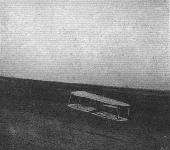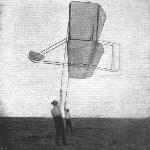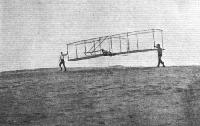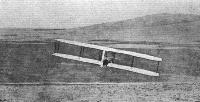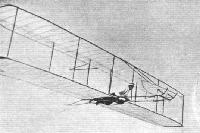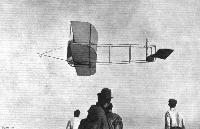
Описание
Страна: США
Год: 1900
Планер
A.Andrews. The Flying Machine: Its Evolution through the Ages (Putnam)
Wilbur and Orville Wright, aged 32 and 28 respectively in 1899 when they began to study aeronautics seriously, were the sons of a bishop of the United Brethren Church living in Dayton, Ohio. They had built up a modest business success in selling, and later making, cycles. By that time they had been attracted by the exploits of Lilienthal and had closely studied the flight of birds. In 1899 they acquired, among other works whose titles they had requested from the Smithsonian Institution in Washington, Chanute’s great summary of the technical progress of aeronautics, and in August of that year they built a biplane kite.
Its wing-span was only 5ft, but it demonstrated from the start the most significant feature of their innovation in aircraft control - the system of wing-warping. This is an inaccurate expression that history has saddled us with. It means that they twisted screw-wise the extremities of the wings to alter the angle made by the wing-tips to the wind, and so control roll caused by currents of unstable air. The increase of resistance (or lift) at one wing-tip and the diminution of lift at the other would induce the machine to return to the horizontal, or to bank. It was a system whereby the pilot - not yet ‘flying by the seat of his pants’, because the Wrights began by flying in a prone position - developed an intuitive reaction to what was happening to the machine and an increasingly speedy correction of its attitude by mechanical means, which were also improving.
From the outset the Wrights were defying the mainstream of European thought, which decreed the construction of an inherently stable aeroplane. Only the glider pilots Lilienthal, Pilcher and Chanute - and Le Bris in his albatross craft of 1857 and 1868 - had previously rejected this trend. The Wrights sought to build inherently unstable aircraft demanding from the pilot continuous control in flight. Wilbur was uncompromising about this ‘fundamentally different principle’. Their resolve, he said, was that ‘we would arrange the machine so that it would not tend to right itself’.
Their small-scale biplane kite of 1899 was succeeded by their No 1 glider in 1900. This had fixed biplane wings with a span of 17ft and a horizontal plane braced for ward of the wings to act as elevator and to protect the pilot in nose-dive crashes. This elevator moved up and down automatically as the glider changed its fore-and-aft attitude. The wing-warping could be adjusted only from the ground, not during flight. After very few flights the original dihedral wing-setting was cancelled, and with that step the Wrights abandoned all formal automatic stability. Like Pilcher, they had found the effect of the lateral dihedral too extreme to master in strong irregular gusting wind.
In 1901 they constructed their No 2 glider, with the wings, cambered after trials to a new curvature of 1 in 19, measuring roughly 22ft by 6ft 6in, giving an area of 290 sq ft, and having a slight anhedral droop. They had now fashioned a hip-cradle in which the pilot lay face down, and, by turning his body to right or left, he could warp the wings. This machine was tested with fair success near the Kill Devil sandhills, south of Kitty Hawk in North Carolina, where there was fairly constant strong wind and soft sandy landing. The glider was launched by being run by hand into a strong wind, the two ground staff holding the wing-tips.
After intensive redesign in 1902, which included wind-tunnel research to test aerofoil sections, the Wrights built their No 3 glider, with reduced wing camber, maintained anhedral droop, and a slightly increased wing-span to 32ft, giving with decreased chord an area of 305 sq ft. Initially they had a fixed double fin at the rear, but after some disastrous spins they replaced this with a movable single rudder, its controls always linked to the warp-cradle so that it invariably turned in the direction of bank. With this vital innovation the brothers made up to 1,000 controlled glides in the autumn of 1902 and became highly experienced pilots. They once noted without rancour that during five years of experimental gliding Otto Lilienthal had been airborne for little more than five hours; it seems that they logged at least half this flying time during five weeks in 1902 alone, with a maximum glide of over 200yd in 26 seconds.
Описание:
- A.Andrews. The Flying Machine: Its Evolution through the Ages (Putnam)
- Журнал Flight
Фотографии
-
A.Andrews - The Flying Maschine: Its Evolution through the Ages /Putnam/
The Wrights’ No 1 glider, 1900, being flown as a tethered kite, the wing-warping not being adjustable in flight. What they called the ‘horizontal rudder’ - the horizontal adjustable forward elevator - is not obvious because of the angle of the photograph.
-
P.Jarrett - Pioneer Aircraft: Early Aviation Before 1914 /Putnam/
The Wright's 1900 glider being flown as a kite at Kitty Hawk.
-
P.Jarrett - Pioneer Aircraft: Early Aviation Before 1914 /Putnam/
Wilbur (left) and Orville fly the 1901 glider as a kite. This machine failed to come up to expectations.
-
A.Andrews - The Flying Maschine: Its Evolution through the Ages /Putnam/
The Wrights’ No 2 glider of 1901 had an anhedral droop to the wings and the pilot lay in a hip cradle by which he controlled wing-warping.
-
Журнал - Flight за 1909 г.
A low glide on the 1901 model. Often the machine was only a few inches from the ground.
-
Журнал - Flight за 1909 г.
A high glide with the 1901 model, which had neither tail nor rudder, steering being effected by warping the wings.
-
P.Jarrett - Pioneer Aircraft: Early Aviation Before 1914 /Putnam/
Wilbur Wright aloft in the 1901 glider. The problem they encountered with this glider led the Wrights to undertake their unprecedented programme of windtunnel tests.
-
Журнал - Flight за 1909 г.
Testing a Glider by Soaring. - The above view shows the glider soaring stationary in the wind. The machine shown is the early 1902 model, with the fixed double tail before it was converted into a rudder.
-
Журнал - Flight за 1909 г.
Launching the 1902 glider on 10 October. Orville is piloting, and Wilbur is at the starboard wingtip. Note the single, fixed vertical rear rudder.
-
A.Andrews - The Flying Maschine: Its Evolution through the Ages /Putnam/
The launching technique for the Wright gliders, in this case their No 3 of 1902 after modification that substituted a single rear rudder for the previous two fixed fins.
-
Журнал - Flight за 1909 г.
Turning to the right. A view from behind of the later 1902 model after it had its rear tail converted into a rudder.
-
Журнал - Flight за 1909 г.
At close range, showing very clearly the exact position occupied by Wilbur Wright in gliding. The machine illustrated is the 1902 model fitted with a rudder.
-
P.Jarrett - Pioneer Aircraft: Early Aviation Before 1914 /Putnam/
A successful practice glide in the 1902 glider in October 1903, after it had been fitted with twin moveable rear rudders. The Wrights' basic living accomodation and hangar are visible below.
-
Журнал - Flight за 1911 г.
THE WRIGHT GLIDER IN OPERATION BY ORVILLE WRIGHT AT KILL DEVIL HILL, NORTH CALIFORNIA. - The photograph was taken from beneath, during the time when the glider was stationary in the air.
-
Журнал - Flight за 1913 г.
Sketch from a photograph of a Wright glider in ilight. - The first of these machines was built in 1900, and it had wing warping control. When first used the vertical rear plane was fixed, but later it became a pivoted rudder, and then the power-driven aeroplane was arranged for convenient simultaneous control with the warp.
-
G.Loening - Takeoff into Greatness /Putnam/
The first page of the Wright patent.





